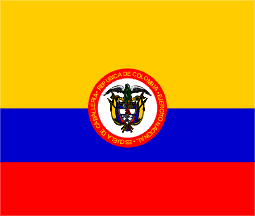 (~4:5)
(~4:5)image by Željko Heimer, 17 May 2001

Last modified: 2006-06-09 by dov gutterman
Keywords: colombia | intelegence | bicol | mfo |
Links: FOTW homepage |
search |
disclaimer and copyright |
write us |
mirrors
See also:
 (~4:5)
(~4:5)
image by Željko Heimer, 17 May 2001
Ratio ~4:5. Adopted: 17 May 1924. In use except small changes
of the shield. In the red circle the name of the army unit that
is using it should be written .
Jaume Ollé, 25 July 1996
This flag and the Cavalry Flag are my
"reconstruction" with what I think is reasonable to
expect what's written on the red ring, exaple for a mounted unit
and example for the Army (assuming that the army as whole would
have the infantry version of the colours). The image is based on
site <www.escaballeria.mil.co>.
There are few photos of the flag there but non good enough to
provide for the text. I was not able to find an other infantry
unit, so the Cavalry Flag image is maybe a
streching a bit too far.
Željko Heimer, 17 May 2001
Article 3 - the war flag used by the Army is one meter and
thirty centimeters long and one meter and ten centimeters wide
for the units on foot and the standard for the mounted units
should be one meter long and one meter wide. These flags shall
have in the center the coat of arms of the Republic surrounded
with a ring of red (velvet?) five centimeters wide and forty
centimeters of the outer diameter in which is inscribed in golden
letters the name of the unit to which it belongs.
Decree Nr. 62 of 1934 (January 11) - 208. The war flag used by
the Army shall be, in accordance to the law, one meter and thirty
five centimeters long and one meter and ten centimeters wide, for
the mounted units. This flag shall have in the center the coat of
arms of the Republic, set in an oval of red cloth on which shall
be inscribed, in letters outlined in gold the name of the unit or
military division to which it belings.
209. The flag with the coat of arms shall only be used by the
armed forces of the Nation.
Željko Heimer, 17 May 2001
Variants (?)

image by Jaume Ollé, 27 October 2001

image by Jaume Ollé, 27 October 2001
Military flag as legislate and as it is. Naval ensign,
military flag and cavalry standart was kept without change by
resolutions 64 (9-1-1961) and 4235 (1965) and still in use.
Jaume Ollé, 27 October 2001
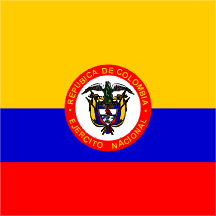 (1:1)
(1:1)
image by Željko Heimer, 17 May 2001
Ratio 1:1. Adopted: 17 May 1924. In use except small changes
of the shield.
Jaume Ollé, 25 July 1996
Variants (?)
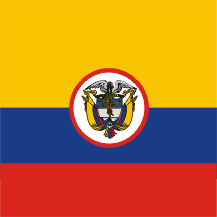
image by Jaume Ollé, 27 October 2001

image by Jaume Ollé, 27 October 2001
Cavalry standart as legislate and as it is used. Naval ensign,
military flag and cavalry standart was kept without change by
resolutions 64 (9-1-1961) and 4235 (1965) and still in use.
Jaume Ollé, 27 October 2001
The Cavalry Flag is not really a flag. It is merely the
Colombian flag with a sumperimposed shield. I have seen this
symbol many times in armored units of the Army in Bogota (Capital
of Colombia). What the shield reads is: "Republica de
Colombia - Ejercito Nacional - Escuela de Caballeria". The
"Escuela de Caballeria" is actually a training facility
located in Bogota to train the soldiers and officers in charge of
the armored units of the Army. You can also find several
"Caballeria" facilities troughout the country as they
are used on a permanent basis to support ground troops that
engage in combat.
Jorge Eduardo Alonso, 8 June 2002
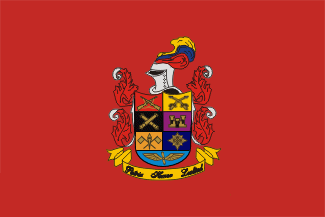
image by Eugene Ipavec, 22 August 2005
reverse
image by Eugene Ipavec, 3 March 2006
The new Colombian Army flag (it is "new" because the
Army's Coat of Arms has been slightly changed - see below).
Source: <www.revistaaeronautica.mil.co>.
E.R., 22 August 2005 and 5 June 2006
In the new Coat of Arms, the inscription in the scroll seems
to have been changed. Tho old one was "Patria, Honor,
Libertad" . The new Coat of Arms seems to have a longer
motto - looks like four words.
Eugene Ipavec, 22 August 2005

image by Eugene Ipavec, 2 June 2006
Another version of the flag is the plain red background
charged with the new Coat of Arms. The reverse
of the flag is still the same.
Source: Colombian Army's
official website.
E.R., 2 and 5 June 2006
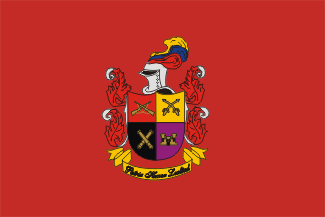
image by Jaume Ollé, 5 November 2001
Ejercito de la Republica de Colombia - This flag can be seen
(in an arty, animated way), at the frame "organizacion"
at <www.mindefensa.gov.co>.
Guillermo Tell, 3 June 2000
I have found the complete description of the Coat of Arms of
the Colombian Army Flag in Spanish:
"Será de forma Suiza, acuartelado en cruz, es decir en
cuatro cuarteles, así:
El cantón diestro del Jefe será de gules, con dos fusiles de
oro, con correas de los mismos, de los cuales uno irá en barra y
otro en Banda es decir, cruzados.
El cantón diestro de la punta será de sable, con dos tubos de
canón en oro cruzados en sotuer.
El cantón siniestro de la punta será en púrpura, con un
castillo almenado en oro.
El cantón derecho del Jefe en gules, el color del fuego y de la
sangre, que conviene a los héroes y a los mártires, simboliza
fortaleza, victoria, osadía, alteza y ardid, cualidades
inherentes al infante, cuya idiosincrasia trata de representarse
con este color. En el centro de este cuartel van dos fusiles
cruzados uno en barra y otro en banda. El fusil es el arma
básica de un Ejército, por eso esta figura está en la parte
más importante para este caso, del escudo . Las cualidades de
ser el arma básica y más antigua le dan la propiedad.
El campo siniestro en oro simboliza juicio, inteligencia, madurez
de espíritu, nobleza, magnanimidad, riqueza, poder y sabiduría.
Este cuartel lleva de oro dos sables cruzados en sotuer y por si
mismos representan la caballería, cuyo patrono, San Jorge, es
espejo de gentiles hombres.
El cantón diestro de la punta en sable significa la idea de la
sombra misteriosa, prudencia, sin reparos, caracteriza lo que
esta más allá de la inteligencia ,lo ignoto, color seco y duro
que evoca al hierro, a la ceniza. Simboliza también la tristeza,
el rigor, la humildad y la franqueza, color de luto.
Lleva de oro dos tubos de canón en sotuer, es la insignia por
excelencia de los artilleros que el cuatro de diciembre evocan a
su patrona, Santa Bárbara.
El cantón siniestro de la punta lleva de púrpura un castillo de
tres torres almenadas en oro.
La púrpura significa modestia, prudencia, humildad, soledad,
deseo y nostalgia del triunfo, es el color de la cereza en
sazón.
El castillo con torres almenadas habla del fortalecimiento
logrado a base de voluntad y esfuerzo humano.
Timbre
El escudo estará timbrado por un yelmo en acero brunido mirando
a la derecha como símbolo de legitimidad.
La calva del casco llevará como cimera tres plumas con los
colores de la Bandera Nacional.
Adornos exteriores
Llevará a cada lado lambrequines o lamequines de hojas de acanto
en gules y plata.
Divisa o Empresa
Llevará a cada lado lambrequines o lamequines de hojas de acanto
en gules y plata."
Source: Official Website of the Colombian Army at <www.ejercito.mil.co>.
Santiago Tazon, 22 January 2002
Distinctive sign in military vehicles
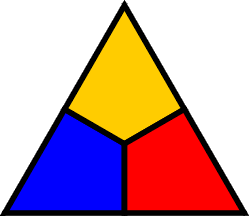
image by António Martins-Tuválkin, 15 June 2005
The distinctive sign in military vehicles used in Colombia.
Source: "Himnos y Símbolos de Nuestra
Colombia", page 182. Written in 2000 by Julio Cesar García,
edited by Camer Editores. ISBN 958-33-1489-7.
I am not aware that this symbol is used on a flag.
E.R., 12 June 2005
This looks suspiciously like the interwar emblem of Armor in
the US Army, and the triangular shape and color arrangement is
still used by Armored formations; divisions, I believe, have
their number in black on the yellow apex, and there is often a
motto, slogan, or nickname in a separate label at the bottom
beneath the actual emblem.
Ron Lahav, 12 June 2005
.jpg)
image from <www.ejercito.mil.co>
There has been a recent change in the Coat of Arms of the
Colombian Army published on the Army's official website on May
17, 2005, the image and also the official explanation in Spanish.
Most important facts:
1. The current version of the Colombian National Army Coat of
Arms was designed back in 1936 and had been unmodified until very
recently.
2. The new modification was introduced under Resolution No. 0523
of 2005 by the Army Commander, to include the recently created
Army Branches: - Aviación del Ejército (Army's Aviation),
created in 1990 - Inteligencia Militar (Military Intelligence),
created in 1996 - Comunicaciones (Communications), created in
1997.
From top to bottom (left to right), the colors and arms of the
following Branches are represented in the Coat of Arms:
- Top left: two crossed rifles over red background: Infantry
- Top right: two crossed swords over yellow background: Cavalry
- Middle left: two crossed cannons over black background:
Artillery
- Middle right: brick castle over purple background: Engineers
- Lower left: two crossed signal flags over orange background:
Communications
- Lower right: a compass on purple background: Military
Intelligence
- Bottom: pilots wings over blue background: Army
Aviation.
It is also worth noticing that each Army Battalion/Brigade
(depending on the Branch) will have the background colors
displayed on the Coat of Arms, plus the Coat of Arms of that
specific unit.
Source: <www.ejercito.mil.co>
E.R., 12 June 2005
army.gif)
image by Jaume Ollé, 5 November 2001

Army (EJC)
image by Carlos Thompson, 2 June 2003
Navy (ARC)
image by Carlos Thompson, 2 June 2003

Air Force (FAC)
image by Carlos Thompson, 2 June 2003
In the front dor of the Military Hospital, in Bogotá,
Colombia, there are three flags in plain color: dark blue, light
blue and red. I supose that the flags are just versions without
the coat of arms, of the flags of the Army (EJC), Navy (ARC) and
Air Force (FAC). I have also seen the red flag at the Cadet
School, in Bogota.
Carlos Thompson, 2 June 2003
António Martins wrote: "These seem to follow
the british pattern...". Given that Colombia military
airfield flag follows a British pattern: sky blue flag with
national flag in the canton and roundel in the fly; and that
Britain had a lot of influence in Latin America post
independence, that would be a fair guess.
Carlos Thompson, 3 June 2003
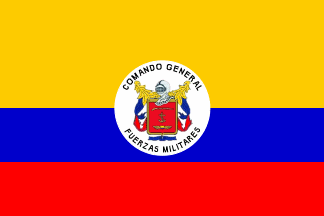
official flag
image by Eugene Ipavec, 26 December 2004
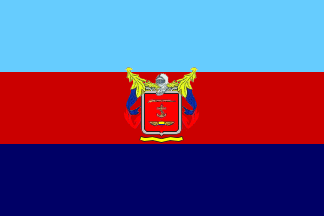
additional official flag - obverse
image by Eugene Ipavec, 15 February 2006

additional official flag - reverse
image by Eugene Ipavec, 15 February 2006
Comando General de las Fuerzas Militares - Colombia (General
Command of Military Forces) - This flag can be seen (in an arty,
animated way), at the frame "organizacion" at <www.mindefensa.gov.co>.
Guillermo Tell, 3 June 2000
Website at <www.cgfm.mil.co>.
The flag is divided into three horizontal equal stripes, with
light blue (top), red (middle) and dark blue (bottom). The CGFM
(for its initials) was created by Decree No. 835 of April 16,1951
and its in charge of the Planinng and Strategic guidelines of the
Colombian Armed Forces.
I would also like to mention that the colors of this flag are the
same (only inverted) to the flag of "British
joint services flag in the Falklands", so probably the
Colombian military use this flag to design their own. The colors
on the Colombian CGFM flag are light blue on top (airforce), red
on the middle (ground forces) and dark blue on the bottom (navy).
E.R., 25 July 2005
However, in the shield at the center of the arms the symbols
of the services are, top to bottom, Army (rifle), Navy (anchor)
and Air Force (winged mini-shield). Perhaps they were placed in
order of seniority.
Eugene Ipavec, 26 July 2005
This is correct: The symbols displayed (from top to bottom)
are indeed in order of seniority. The Army was the first Force
(its foundation date is considered 1819, the year the Battle of
Boyaca was fought and Colombia gained its independence from
Spain). The second Force was the Navy (its foundation date is
considered to be 1824, the year the Naval Battle of Maracaibo was
fought, defeating the whole Spanish domain in the South American
territory, except for minor engagements that took place inland in
1825). The last Force created was the Air Force (its foundation
date is considered to be 1919, when Colombian President Marco
Fidél Suárez established the Air Arm, as a Branch of the Army).
E.R., 26 July 2005
All military flags in Colombia have one version in tricolour
flag and the other one with the Coat of Arms and background
colors. Sources for the first version are <www.cgfm.mil.co> and <www.mindefensa.gov.co>.
E.R., 26 December 2004
The color composition of additional official flag is as
follows: Light blue on top, which represents the Air Force, and
should be the same shade as the Air Force plain flag. Red in the
middle, which represents the Land Force (Army), and should be the
same shade as the Army plain flag. Dark blue on bottom, which
represents the Sea Force (Navy), and should be the same shade as
the Navy plain flag. In the obverse it has the coat of arms and
on the reverse it is plain.
E.R., 28 January 2006
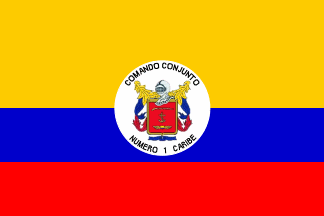
image by Eugene Ipavec, 5 February 2006
There's a military Task Force in Colombia recently created
which is higher than an Army Division (in the Military
hierarchy). It is only a temporary task force, but it comprises a
lot of military manpower, so it is very important. The official
name is Comando Conjunto No. 1 'Caribe' (Joint Command No. 1
'Caribbean'), and it comprises the Army's First Division, and the
Navy's First Marine Infantry Brigade, plus some other smaller
units.The flag is the Colombian tricolor, plus the Coat of Arms
of the General Forces Military Command. The image looks pretty
similar to the alternate version of the General Forces Military
Command, only that the lettering changes a bit: on the top it
reads COMANDO CONJUNTO, and on the bottom reads NUMERO 1 CARIBE.
E.R., 5 February 2006
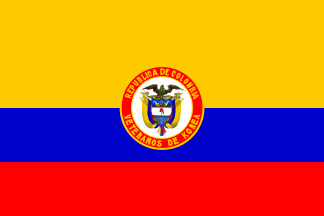
obverse
image by Eugene Ipavec, 8 December 2005
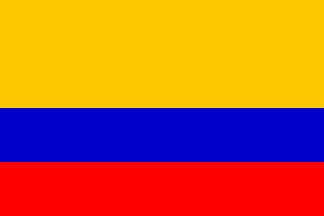
reverse
image by Eugene Ipavec, 10 March 2006
This is the official flag of the Korean War Veterans from
Colombia. It is the same as the AFEAU flag,
only that on the bottom fringe it reads "VETERANOS DE
KOREA" (Please notice that Korea is spelled in English,
because in Spanish it is Corea, but somehow they put it in
English). The picture was taken from the website of the Ministry
of National Defense (<www.mindefensa.gov.co>)
durign the 50th anniversary of the participation of troops from
Colombia in the Korean War, under the US command leading the
UN-forces. In the picture are the former Minister of Defense and
the former Commander General of the Military Forces back in an
award ceremony in 2002.
E.R., 8 December 2005